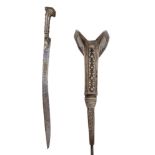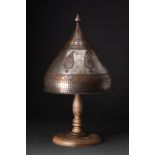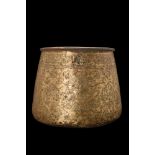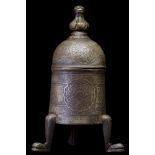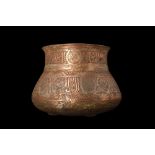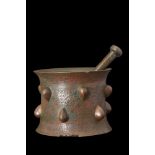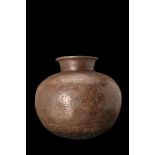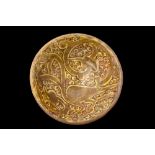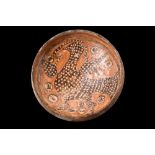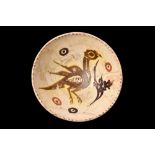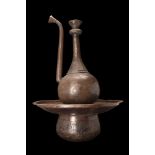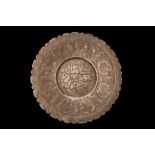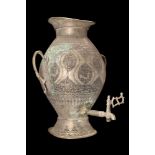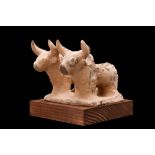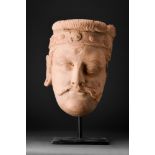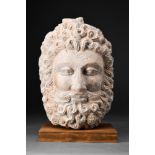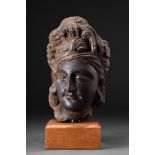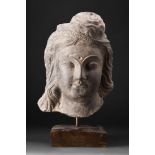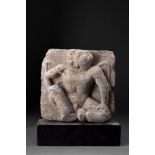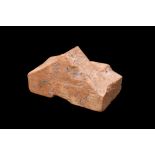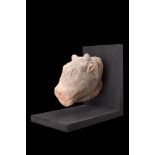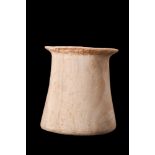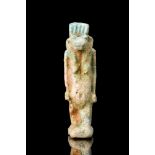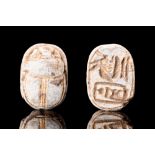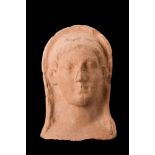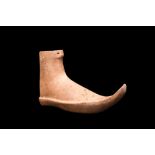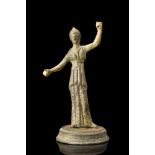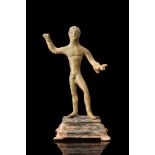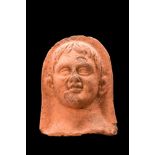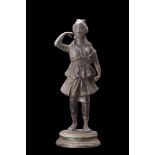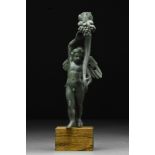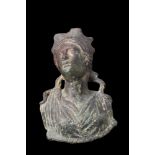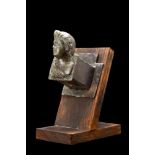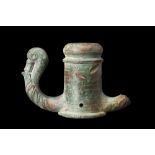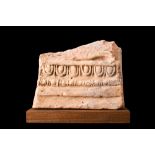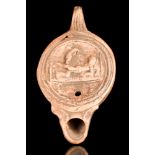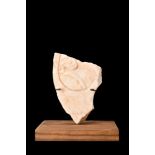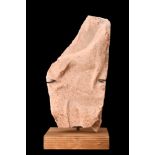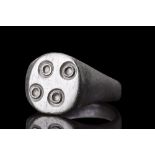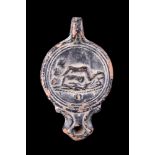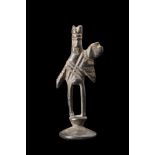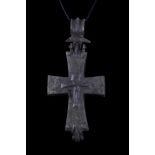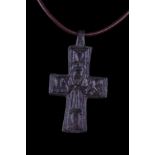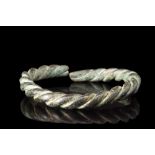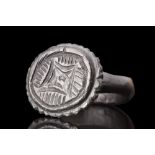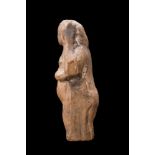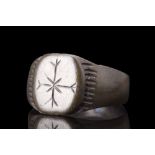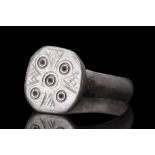Filtered by:
- Category
- List
- Grid
A subscription to the Price Guide is required to view results for auctions ten days or older. Click here for more information
Ca. 19th century AD. With a characteristic form eared silver hilt decorated with repousse and engraving, recurved single-edged blade with gold inl...
SAFAVID STEEL HELMET
Ca. 17th century AD. This steel helmet is a masterpiece of craftsmanship and elegance, a true testament to the artistry of its makers. Its conical...
TIMURID BRASS POT
Ca. 14th century AD. A brass vessel featuring a round base with walls that gently taper to the opening, which is adorned with a rounded rim. The e...
Ca. Late 19th to 20th century AD. A brass incense burner of a wide tubular body richly decorated with silver inlays, resting on three feet with st...
TIMURID DECORATED COPPER BOWL
Ca. 14th century AD. A copper bowl featuring a rounded base on top of three small feet. Its sides gradually taper to a tubular neck with an everte...
KHORASAN BRONZE DECORATED MORTAR
Ca. 1150-1200 AD. A cast bronze mortar and pestle of tubular form, with a flaring bottom and upper flange that give it a sturdy and substantial pr...
ISLAMIC BRASS DECORATED VESSEL
Ca. 17th-19th century AD. A large vessel with a globular body and rounded base, and a short, funnel-shaped neck with an everted rim, culminating i...
ABBASID POTTERY BOWL WITH A BIRD
Ca. 1000-1100 AD. A splendid pottery bowl of flaring form that enchants with its unparalleled beauty and masterful craftsmanship. The bowl's lumin...
SAMANID POTTERY BOWL WITH A BIRD
Ca. 900-1000 AD. Crafted with utmost care and attention to detail, this bowl boasts a deep and alluring form, standing on a low ring foot that len...
Ca. 1000-1100 AD. A pottery bowl of a hemispherical form resting on a low ring foot with the interior featuring a central depiction of an ochre-pa...
Ca. 19th century AD. A brass ewer and basin set including a slender ewer that rises from a concave splayed foot. Its lower body is globular in sha...
ISLAMIC DECORATED BOWL
Ca. 17th-19th century AD. A nice example of a magic bowl, a captivating work of art that has been crafted to protect and ward off fear, evil, and ...
ISLAMIC DECORATED PLATE
Ca. 17th-19th century AD. A circular plate with a serrated edge, featuring a fine calligraphy inscription in the central recess. The rest of the i...
Ca. 17th-19th century AD. A tinned copper water vessel with a tap is a stunning example of the exquisite craftsmanship of the Islamic world. Its b...
Ca. 3000-2500 BC. A pottery idol showcasing two zebu bulls standing in close proximity to one another on an integral square-shaped base. The atten...
Ca. 200-400 AD. A finely modelled terracotta head of a bodhisattva. A bodhisattva was originally conceived as Gautama on his path to enlightenment...
GANDHARAN HEAD OF HERCULES
Ca. 100-200 AD. A schist head of Hercules with finely carved facial features, from the almond-shaped eyes with heavy eyelids, to the prominent nos...
Ca. 200-300 AD. A carved dark schist head of a bodhisattva with its soft, rounded cheekpieces, lovely smile, and almost closed almond-shaped eyes,...
Ca. 200-300 AD or later. A mesmerizing schist head of a nobleman, a stunning masterpiece of art that reflects the remarkable fusion of Greek and B...
Ca. 200-300 AD. A schist head of a Bodhisattva, a stunning masterpiece of art that embodies the profound spiritual insights of the Buddhist tradit...
Ca. 200-300 AD. A schist panel featuring winged Atlas, an embodiment of strength and power, brought to life through the skills of the Gandharan ar...
CHINESE WOOD BUDDHA WITH AUREOLE
Middle periods, ca. 19th century AD. Carved wood Buddha seated on a multi-tiered fancy integral base. Depicted with a tightly knotted hairdo, elon...
Late Period / Ptolemaic Period, ca. 664-332 BC. A fragment of the edge of a small unidentified magical object which originally must have had a qua...
Late Period, ca. 664-332 BC. A sculpted pottery head of a bull symbolizing the divinity Apis, featuring wonderfully carved facial features, ears, ...
EGYPTIAN ALABASTER VESSEL
New Kingdom, ca. 1550-1070 BC. This cylindrical wonder is expertly sculpted from alabaster, a stone prized for its unique beauty and versatility. ...
Ca. 664-332 BC. An amulet made of blue-green faience. Depicted is the goddess Taweret represented as a female hippopotamus who was considered to b...
Ca. 1504-1450 BC. A fine Egyptian steatite scarab with naturalistic features such as a clypeus and prothorax marked by incised lines. The reverse ...
Ca. early 5th century BC. A rare terracotta protome, featuring a breathtaking visage of a goddess with ethereal beauty. This masterful creation sh...
PHRYGIAN BOOT-FORM RHYTON
Western Anatolia, ca. 800-700 BC. A tan pottery low boot having pointed toe curved off to the side and an incise-stitched sole. Mid ankle length w...
Ca. 300-200 BC. A bronze figurine of a female deity, exquisitely crafted in a standing pose with a subtle sway to her right. This dynamic represen...
Ca. 300-200 BC. A bronze figurine of Herakles, depicted in a commanding standing pose atop a plinth with a stepped profile. The statue features a ...
Ca. 6th-5th century BC. A hollow molded pottery votive head depicting a youthful male head with wavy hair emanating from under a hood. Well-modele...
ROMAN BRONZE STATUETTE OF DIANA
Ca. 1-100 AD. A captivating bronze statuette of the goddess Diana, also known as Artemis in Greek mythology. This exquisite piece depicts the godd...
Ca. 100-200 AD. The figure is of a young boy, standing naked on the tips of his toes, as if he were mid-dance. The boy’s ethereal nature is highli...
Ca. 100-200 AD. A bronze protome of a goddess with her head slightly tilted to the side as if she were gazing upon something that caught her eye. ...
Ca. 100-200 AD. A bronze bust of the God Apollo, exquisitely crafted and expertly rendered. This captivating piece portrays the deity emerging fro...
Ca. 100-200 AD. A bronze chariot fitting in the form of a tubular shaft, adorned with a delicately domed finial, which would have been a striking ...
Ca. 100-300 AD. A marble relief fragment adorned with a mesmerizing ovolo decoration register, it exudes an air of opulence and refinement that is...
Ca. 1-200 AD. A moulded pottery oil lamp, Loeschcke form I, with an erotic scene depicted in the tondo. The scene features the woman reclining on ...
Ca. 100-300 AD. A fragment of a marble plaque with an intricate floral pattern in relief. The fragment is an exceptional example of the exquisite ...
Ca. 100-300 AD. A terracotta brick fragment featuring a low relief depiction of a majestic lion with its slender outstretched body. The fragment i...
Ca. 200-500 AD. A bronze ring with a round hoop, and circular bezel decorated with a set of four irregularly placed 'ring and a dot' patterns, pro...
An ancient Roman-style terracotta oil lamp with a dark grayish brown glaze featuring a circular body with a recessed discus, which is embellished ...
Ca. 1st-3rd century AD. A bronze statuette of an archer. The figure is depicted standing upright, with his long legs placed on an integral spool-s...
Ca. 800-1000 AD. A cast-bronze reliquary cross pendant composed of two cruciform plaques that fit together, a hinged mechanism to the top and bott...
Ca. 800 AD. A bronze cruciform pendant in the form of a Latin cross decorated with a depiction of Jesus between busts of saints to each arm. The C...
Ca. 900-1100 AD. A penannular bronze bracelet crafted from a single piece of bronze. It features a mesmerizing twisted body that creates an intric...
Crusaders Era, ca. 1100-1400 AD. A bronze finger ring with a slender hoop, finely etched shoulders, and a flat oval-shaped bezel decorated with a ...
Ca. 14th-15th century AD. A captivating example of Medieval religious art - a votive figure or an amulet, fashioned in the likeness of the Mother ...
MEDIEVAL BRONZE RING WITH CROSS
Norman, ca. 11th century AD. A bronze ring crafted with skillful hands, it features a broad flat-section hoop that gradually expands into a bezel ...
Ca. 600-800 AD. A bronze finger ring featuring a unique decoration of five concentric circles arranged in a cruciform pattern. Each of the five ci...

